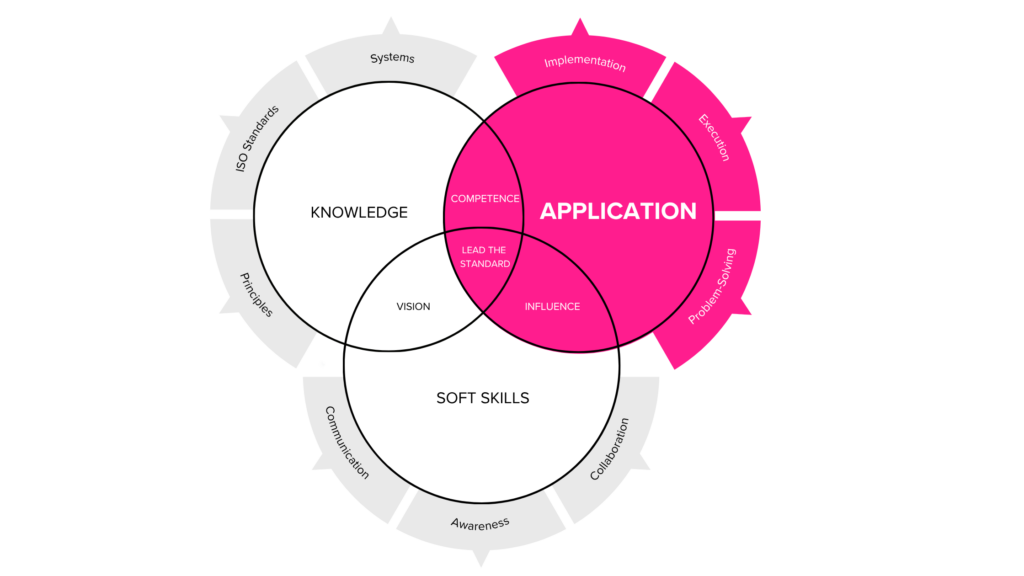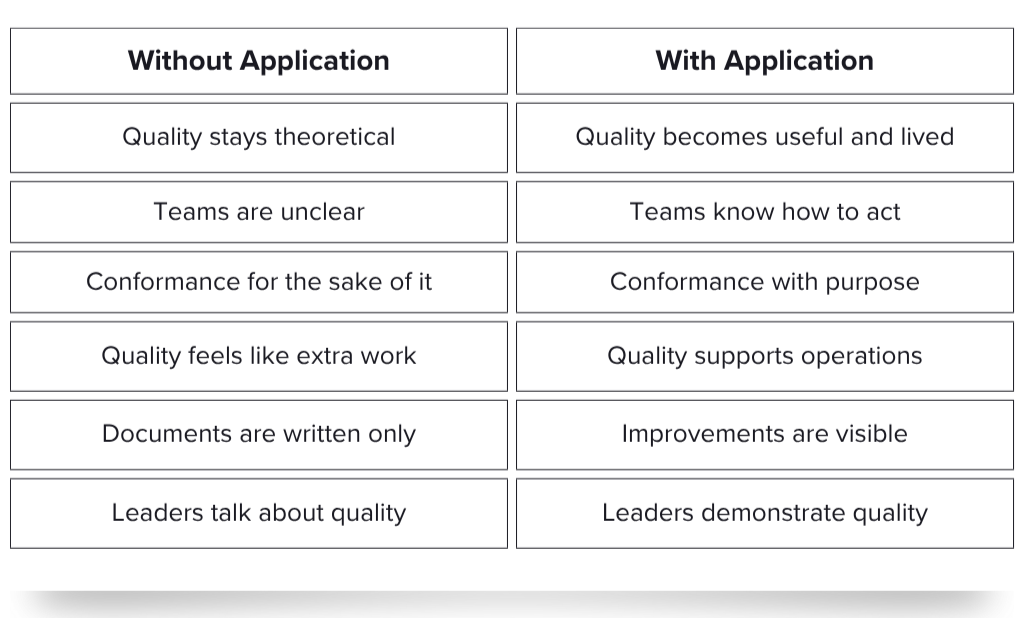November 13th, 2025

—
Now that we’ve conquered the Circle of Knowledge, we’re feeling pretty good. We’ve got a strong foundation. We know the standards and sharpened our interpretation skills. We’ve learned our systems holistically. And the reason it feels good is because knowledge is powerful. But it’s only the start. It’s not enough on its own.
The long and short of it is that even if you know every clause of the standard, even if you sit in every training session, tick every box and even pass every audit, if you’re not applying the standard in a way that actually impacts your business, then what’s the point?
Real leadership comes from having the knowledge and applying it. It’s about translating what you know into how you work, how you lead and how you improve. That’s where the real transformation happens.
You can think of it like this. Quality principles are like road signs. They’re helpful, but only if you actually follow them while driving. They’re pretty useless if you just stand on the sidewalk and admire the signage.
Knowing what the sign means doesn’t get you to your destination. Using it does.
When I first started as a trainer, I had to learn this lesson the hard way.
I had all the slides. I was competent, had the required qualifications, the slides were detailed and the entire process was very ‘quality’. But guess what? No one cared. No one learned. And no one bought into the process. Because theory without connection was just noise.
So I started pulling in real stories about real situations and real people. I’d link each concept to something tangible and relatable, so it was something they could feel and connect with. In other words, I started applying the standards… and that’s when lightbulbs started going off. That’s when the learning stuck.
You can’t just know the standard and expect change. You’ve got to bring it to life. The Circle of Application gives you the way to do this so you have real impact with your quality.
—

—
What is the Circle of Application?

The Circle of Application is about moving from theory to action. This goes from knowing what good looks like to doing the work to get there. It’s the bridge between theory and practice – where you stop talking about quality and start doing quality. In fact, it’s where quality management actually starts to improve quality.
In the Quality Leadership Model, the Circle of Application is made up of the three practical, interlocking Essentials:
- Implementation – how you set things up. These are the structures, processes and systems you create to align your setup with your strategy and make sure that your quality is designed to work, not just impress auditors.
- Execution – how you keep things going. This is the daily discipline of making sure the system is lived. It’s how procedures are followed, improvements are tracked and teams stay engaged.
- Problem-solving – how you deal with the hiccups (because there will always be hiccups!). This Essential is about using mistakes as momentum. Blame is pointless – but being able to learn, adapt and build resilience into your system is the real gold.
These key Essentials show us where real quality leadership takes place. We can think of the Circle of Application like running an advanced machine:
- Implementation is the design and assembly.
- Execution is the day-to-day operation.
- Problem-solving is the maintenance, troubleshooting and upgrades that keep it performing well.
Together these elements form the practical engine of quality leadership. They’re how you build momentum, keep it moving and make course corrections along the way. And this is where real quality leaders are made. Not in training rooms, but in the messy, human, dynamic environment of a real business.
Why application matters
Let me tell you about Paul. Paul is now a highly-motivated quality manager… but he used to absolutely push back on quality systems. He’d had a terrible experience years earlier. A quality management system had been implemented in his workplace with zero consultation, lots of jargon and a ton of admin. This meant a lot more work for him with almost no benefits. Even though everything looked great on paper, everything was worse in reality, and this left a bad taste. When he left that role to start his own business, he carried that resentment with him.
So for years he did just enough to scrape through audits. No more and no less and with no real benefits to him. And certainly without any real engagement and an attitude to boot.
But then something shifted. He started to realise that the quality management system could reduce his business risks. He realised it could help him grow with more ease and clarity. And slowly, the system started to click. And when it did, it wasn’t a burden any longer, but a tool.
Eventually, Paul went on to implement and get certified against ISO 14001 (environment) and ISO 45001 (OH&S) – without being required to by his customers. He held his suppliers accountable. He brought his team into the system. He started leading quality. His training and use stopped being theoretical, and started being practical. His procedures began to support his actual workflows and the business saw real improvements. Slowly and surely the system came to life – not just because Paul knew the standards – but because he knew how to apply it.
That’s the Circle of Application in action. And that’s what can happen when you stop doing quality just for the certificate, and start leading it for the impact.
As the quote from John Ruskin says, ‘Quality is never an accident; it is always the result of intelligent effort.’ And that’s precisely what Paul found.
Application matters because it teaches us how to implement quality systems that actually work in real-world conditions. It shows us how to keep those systems alive through consistent application and it reveals how to handle problems in a way that leads to learning, not blame.
These are practical, powerful essentials that help you lead the standard, not just follow it.
But when we can’t do that – if we can’t apply what we know – then we’re in danger of staying stuck in theory. When quality remains academic, it causes confusion. Teams disengage.
Nothing changes. Everything stalls.
If we can’t apply what we know, quality becomes just another binder on the shelf. The audits might pass, but the business doesn’t improve. Like Paul you’re in danger of being frustrated or even ‘hating’ quality. Even if you do push forward you’ll likely lose confidence, and any systems that you work on – even well-intentioned – will just become background noise. Annoying and pointless.
But when you apply your knowledge? That’s when quality becomes simpler, stronger and a true business asset. And that’s why the Circle of Application matters.
Putting quality application into action
So we know that quality needs both understanding and application. We also recognise that this is how you bridge the gap between knowledge and leadership. And guess what? You don’t need a big system overhaul to get there. You just need to focus on application.
But what does this look like in real life – in practice? How do you put quality application into action?

—
But when we can’t do that – if we can’t apply what we know – then we’re in danger of staying stuck in theory. When quality remains academic, it causes confusion. Teams disengage. Nothing changes. Everything stalls.
If we can’t apply what we know, quality becomes just another binder on the shelf. The audits might pass, but the business doesn’t improve. Like Paul you’re in danger of being frustrated or even ‘hating’ quality. Even if you do push forward you’ll likely lose confidence, and any systems that you work on – even well-intentioned – will just become background noise. Annoying and pointless.
But when you apply your knowledge? That’s when quality becomes simpler, stronger and a true business asset. And that’s why the Circle of Application matters.
Putting quality application into action
So we know that quality needs both understanding and application. We also recognise that this is how you bridge the gap between knowledge and leadership. And guess what? You don’t need a big system overhaul to get there. You just need to focus on application.
But what does this look like in real life – in practice? How do you put quality application into action?
Your Next Knowledge Steps
1. Translate principles into behaviour – Your first step is to demonstrate or model this for your team. Don’t just say ‘we follow quality’ – show what that looks like in practice.
2. Drop the jargon – Stop using language that’s just straight out of the standards. Use real language and make it relevant to your business and your situation.
3. Align the standards with your real workflows – Build quality into what people already do. Don’t make it an extra job. This just makes everything harder and people more resentful.
4. Focus on the impact of quality – Don’t chase documents or checklists – chase results.
You’ve just read a small part of the book! The full version is coming soon—pre-order now and be among the first to read it when it’s released.
View comments
+ Leave a comment